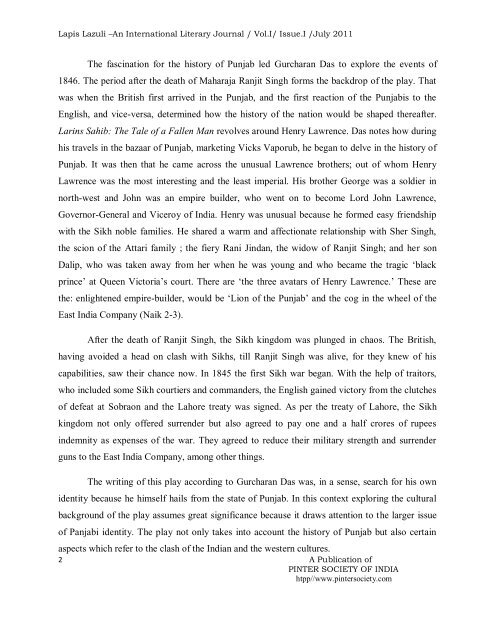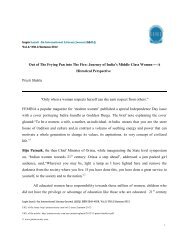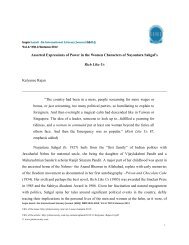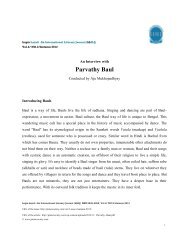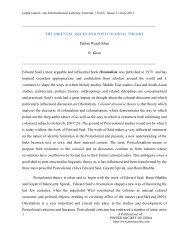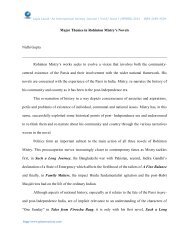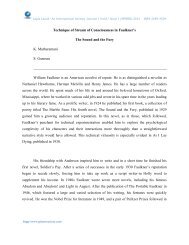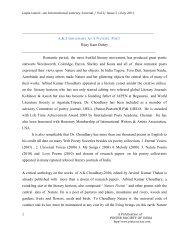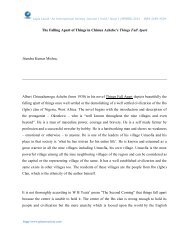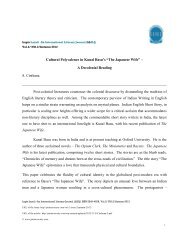You also want an ePaper? Increase the reach of your titles
YUMPU automatically turns print PDFs into web optimized ePapers that Google loves.
Lapis Lazuli –An International Literary Journal / Vol.I/ Issue.I /July 2011<br />
The fascination for the history of Punjab led Gurcharan Das to explore the events of<br />
1846. The period after the death of Maharaja Ranjit Singh forms the backdrop of the play. That<br />
was when the British first arrived in the Punjab, and the first reaction of the Punjabis to the<br />
English, and vice-versa, determined how the history of the nation would be shaped thereafter.<br />
Larins Sahib: The Tale of a Fallen Man revolves around Henry Lawrence. Das notes how during<br />
his travels in the bazaar of Punjab, marketing Vicks Vaporub, he began to delve in the history of<br />
Punjab. It was then that he came across the unusual Lawrence brothers; out of whom Henry<br />
Lawrence was the most interesting and the least imperial. His brother George was a soldier in<br />
north-west and John was an empire builder, who went on to become Lord John Lawrence,<br />
Governor-General and Viceroy of India. Henry was unusual because he formed easy friendship<br />
with the Sikh noble families. He shared a warm and affectionate relationship with Sher Singh,<br />
the scion of the Attari family ; the fiery Rani Jindan, the widow of Ranjit Singh; and her son<br />
Dalip, who was taken away from her when he was young and who became the tragic ‗black<br />
prince‘ at Queen Victoria‘s court. There are ‗the three avatars of Henry Lawrence.‘ These are<br />
the: enlightened empire-builder, would be ‗Lion of the Punjab‘ and the cog in the wheel of the<br />
East India Company (Naik 2-3).<br />
After the death of Ranjit Singh, the Sikh kingdom was plunged in chaos. The British,<br />
having avoided a head on clash with Sikhs, till Ranjit Singh was alive, for they knew of his<br />
capabilities, saw their chance now. In 1845 the first Sikh war began. With the help of traitors,<br />
who included some Sikh courtiers and commanders, the English gained victory from the clutches<br />
of defeat at Sobraon and the Lahore treaty was signed. As per the treaty of Lahore, the Sikh<br />
kingdom not only offered surrender but also agreed to pay one and a half crores of rupees<br />
indemnity as expenses of the war. They agreed to reduce their military strength and surrender<br />
guns to the East India Company, among other things.<br />
The writing of this play according to Gurcharan Das was, in a sense, search for his own<br />
identity because he himself hails from the state of Punjab. In this context exploring the cultural<br />
background of the play assumes great significance because it draws attention to the larger issue<br />
of Panjabi identity. The play not only takes into account the history of Punjab but also certain<br />
aspects which refer to the clash of the Indian and the western cultures.<br />
2 A Publication of<br />
PINTER SOCIETY OF INDIA<br />
htpp//www.pintersociety.com


